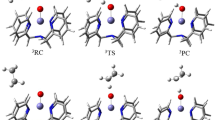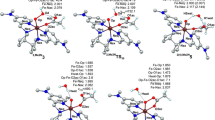Abstract
Nitrene transfer reactions to various hydrocarbon molecules can be efficiently catalyzed by Fe complexes through a mechanism reminiscent of the oxygen transfer function of oxygenase enzymes. Such enzymes exhibit a high-valent iron oxo Fe(IV) = O as the active species, and it has also been proposed that an analogous species, i.e., Fe(IV) = NR (NR being the nitrene group) is responsible for the nitrene transfer activity. We describe here the influence of the Fe(IV) coordination sphere on some key parameters for nitrene transfer efficacy, such as the spin state of the Fe(IV) cation, the electronic affinity, and the bond dissociation energy of the NHR moiety. We explore here the electronic properties of Fe(IV) = NTs (NTs = tolylsulfonylimido group) mononuclear complexes with ligands involving phenolate and nitrogen donor groups, as catalytic properties with such ligands have been found to be quite promising. Six tetradentate ligands were studied, which derive from three different scaffolds: 2-methylenepyridine-N,N-bis(2-methylene-4,6-dichlorophenol) and 2-methylenepyridine-N,N-bis(2-methylene-4,6-dimethylphenol), N,N-dimethyl-N’,N’-bis(2-methylene-4,6-dichlorophenol) ethylenediamine, and N,N-dimethyl-N’,N’- bis(2-methylene-4,6-dimethylphenol) ethylenediamine, N,N’-bis(2-methylene-4,6-dichlorophenol)-N,N’-dimethyl-1,2-diaminoethane and N,N’-bis(2-methylene-4,6-dimethylphenol)-N,N’-dimethyl-1,2-diaminoethane. Thanks to thorough DFT computations, we present some rationalization of the electronic properties of the resulting Fe(IV) = NTs complexes in relation to their coordination sphere and compare them to other Fe(IV) nitrene active species. We show in particular the important role of the anionic character and strong π-donation of the phenolate groups.







Similar content being viewed by others
References
Hili R, Yudin AK (2006) Making carbon-nitrogen bonds in biological and chemical synthesis. Nat Chem Biol 2:284–287. doi:10.1038/nchembio0606-284
Roizen JL, Harvey ME, Bois JD (2012) Metal-catalyzed nitrogen-atom transfer methods for the oxidation of aliphatic C–H bonds. Acc Chem Res 45:911–922. doi:10.1021/ar200318q
Dequirez G, Pons V, Dauban P (2012) Nitrene chemistry in organic synthesis: still in its infancy? Angew Chem Int Ed 51:7384–7395
Roughley SD, Jordan AM (2011) The medicinal chemist’s toolbox: an analysis of reactions used in the pursuit of drug candidates. J Med Chem 54:3451–3479. doi:10.1021/jm200187y
Chang JWW, Ton TMU, Chan PWH (2011) Transition-metal-catalyzed aminations and aziridinations of CH and CC bonds with iminoiodinanes. Chem Rec 11:331–357
Fiori KW, DuBois J (2007) Catalytic intermolecular amination of C − H bonds: method development and mechanistic insights. J Am Chem Soc 129:562–568. doi:10.1021/ja0650450
Au SM, Huang JS, Yu WY et al (1999) Aziridination of alkenes and amidation of alkanes by Bis(tosylimido)ruthenium(VI) porphyrins. A mechanistic study. J Am Chem Soc 121:9120–9132
King ER, Hennessy ET, Betley TA (2011) Catalytic C − H bond amination from high-spin iron imido complexes. J Am Chem Soc 133:4917–4923. doi:10.1021/ja110066j
Vardhaman AK, Barman P, Kumar S et al (2013) Comparison of the reactivity of nonheme iron(IV)–oxo versus iron(IV)–imido complexes: which is the better oxidant? Angew Chem Int Ed 52:12288–12292. doi:10.1002/anie.201305370
Liu Y, Guan X, Wong EL-M et al (2013) Nonheme iron-mediated amination of C(sp3)–H bonds. Quinquepyridine-supported iron-imide/nitrene intermediates by experimental studies and DFT calculations. J Am Chem Soc 135:7194–7204. doi:10.1021/ja3122526
Chandrachud PP, Jenkins DM (2015) High valent FeIV chemistry in sustainable oxidation catalysis. Tetrahedron Lett 56:2369–2376
Mahy J-P, Bedi G, Battioni P, Mansuy D (1988) Aziridination of alkenes catalysed by porphyrinirons: selection of catalysts for optimal efficiency and stereospecificity. J Chem Soc Perkin Trans 2:1517–1524. doi:10.1039/P29880001517
Leeladee P, Jameson GNL, Siegler MA et al (2013) Generation of a high-valent iron imido corrolazine complex and NR group transfer reactivity. Inorg Chem 52:4668–4682. doi:10.1021/ic400280x
Moreau Y, Chen H, Derat E et al (2007) NR transfer reactivity of azo-compound I of P450. How does the nitrogen substituent tune the reactivity of the species toward CH and CC activation? J Phys Chem B 111:10288–10299. doi:10.1021/jp0743065
Rittle J, Green MT (2010) Cytochrome P450 compound I: capture, characterization, and C-H bond activation kinetics. Science 330:933–937. doi:10.1126/science.1193478
Hohenberger J, Ray K, Meyer K (2012) The biology and chemistry of high-valent iron-oxo and iron-nitrido complexes. Nat Commun 3:720. doi:10.1038/ncomms1718
McDonald AR, Jr LQ (2013) High-valent nonheme iron-oxo complexes: synthesis, structure, and spectroscopy. Coord Chem Rev 257:414–428. doi:10.1016/j.ccr.2012.08.002
Farwell CC, Zhang RK, McIntosh JA et al (2015) Enantioselective enzyme-catalyzed aziridination enabled by active-site evolution of a cytochrome P450. ACS Cent Sci 1:89–93
Klinker EJ, Jackson TA, Jensen MP et al (2006) A tosylimido analogue of a nonheme oxoiron(IV) complex. Angew Chem Int Ed 45:7394–7397. doi:10.1002/anie.200602799
Cowley RE, Eckert NA, Vaddadi S et al (2011) Selectivity and mechanism of hydrogen atom transfer by an isolable imidoiron(III) complex. J Am Chem Soc 133:9796–9811
Mehn MP, Peters JC (2006) Mid- to high-valent imido and nitrido complexes of iron. J Inorg Biochem 100:634–643. doi:10.1016/j.jinorgbio.2006.01.023
Thomas CM, Mankad NP, Peters JC (2006) Characterization of the terminal iron(IV) imides [PhBPtBu2(pz‘)]FeIV⋮NAd+. J Am Chem Soc 128:4956–4957. doi:10.1021/ja0604358
Nieto I, Ding F, Bontchev RP et al (2008) Thermodynamics of hydrogen atom transfer to a high-valent iron imido complex. J Am Chem Soc 130:2716–2717. doi:10.1021/ja0776834
Gouré E, Avenier F, Dubourdeaux P et al (2014) A diiron(III, IV) imido species very active in nitrene-transfer reactions. Angew Chem Int Ed 53:1580–1584. doi:10.1002/anie.201307429
25. Avenier F, Latour J-M (2004) Catalytic aziridination of olefins and amidation of thioanisole by a non-heme iron complex. Chem Commun 1544–1545.
Gouré E, Senthilnathan D, Coin G et al (2016) Tautomeric equilibrium within an imido amido diiron species and catalytic two-stage nitrene transfers. Submitted
Velusamy M, Palaniandavar M, Gopalan RS, Kulkarni GU (2003) Novel iron(III) complexes of tripodal and linear tetradentate bis(phenolate) ligands: close relevance to intradiol-cleaving catechol dioxygenases. Inorg Chem 42:8283–8293. doi:10.1021/ic020569w
Kurahashi T, Oda K, Sugimoto M et al (2006) Trigonal-bipyramidal geometry induced by an external water ligand in a sterically hindered iron salen complex, related to the active site of protocatechuate 3,4-dioxygenase. Inorg Chem 45:7709–7721. doi:10.1021/ic060650p
Zhu K, Shaver MP, Thomas SP (2016) Amine-bis(phenolate) iron(III)-catalyzed formal hydroamination of olefins. Chem Asian J 11:977–980. doi:10.1002/asia.201501098
Reckling AM, Martin D, Dawe LN et al (2011) Structure and C–C cross-coupling reactivity of iron(III) complexes of halogenated amine-bis(phenolate) ligands. J Organomet Chem 696:787–794. doi:10.1016/j.jorganchem.2010.09.076
Poli R, Shaver MP (2014) Atom transfer radical polymerization (ATRP) and organometallic mediated radical polymerization (OMRP) of styrene mediated by diaminobis(phenolato)iron(II) complexes: a DFT study. Inorg Chem 53:7580–7590. doi:10.1021/ic5009347
Hasan K, Fowler C, Kwong P et al (2008) Synthesis and structure of iron(III) diamine-bis(phenolate) complexes. Dalton Trans 2991–2998
R. Patra et al (2016) To be published
Kumar S, Faponle AS, Barman P et al (2014) Long-range electron transfer triggers mechanistic differences between iron(IV)-oxo and iron(IV)-imido oxidants. J Am Chem Soc 136:17102–17115. doi:10.1021/ja508403w
Hennessy ET, Liu RY, Iovan DA et al (2014) Iron-mediated intermolecular N-group transfer chemistry with olefinic substrates. Chem Sci 5:1526–1532. doi:10.1039/C3SC52533C
Wang L, Hu L, Zhang H et al (2015) Three-coordinate iron(IV) bisimido complexes with aminocarbene ligation: synthesis, structure, and reactivity. J Am Chem Soc 137:14196–14207. doi:10.1021/jacs.5b09579
Vardhaman AK, Lee Y-M, Jung J et al (2016) Enhanced electron transfer reactivity of a nonheme iron(IV)–imido complex as compared to the iron(IV)-oxo analogue. Angew Chem Int Ed 55:3709–3713. doi:10.1002/anie.201600287
te Velde G, Bickelhaupt FM, Baerends EJ et al (2001) Chemistry with ADF. J Comput Chem 22:931–967. doi:10.1002/jcc.1056
SCM, Vrije Universiteit ADF 2010. SCM, Amsterdam, The Netherlands
Perdew JP, Ernzerhof M, Burke K (1996) Rationale for mixing exact exchange with density functional approximations. J Chem Phys 105:9982–9985. doi:10.1063/1.472933
Handy NC, Cohen AJ (2001) Left-right correlation energy. Mol Phys 99:403–412. doi:10.1080/00268970010018431
Hoe W-M, Cohen AJ, Handy NC (2001) Assessment of a new local exchange functional {OPTX}. Chem Phys Lett 341:319–328. doi:10.1016/S0009-2614(01)00581-4
Swart M, Ehlers AW, Lammertsma K (2004) Performance of the OPBE exchange-correlation functional. Mol Phys 102:2467–2474. doi:10.1080/0026897042000275017
Swart M (2008) Accurate spin-state energies for iron complexes. J Chem Theory Comput 4:2057–2066. doi:10.1021/ct800277a
Conradie J, Ghosh A (2007) Electronic structure of trigonal-planar transition-metal − imido complexes: spin-state energetics, spin-density profiles, and the remarkable performance of the OLYP functional. J Chem Theory Comput 3:689–702
Swart M (2007) Metal–ligand bonding in metallocenes: differentiation between spin state, electrostatic and covalent bonding. Inorg Chim Acta 360:179–189. doi:10.1016/j.ica.2006.07.073
Noodleman L, Han W-G (2006) Structure, redox, pK a, spin. A golden tetrad for understanding metalloenzyme energetics and reaction pathways. JBIC J Biol Inorg Chem 11:674–694. doi:10.1007/s00775-006-0136-3
Stephens PJ, Devlin FJ, Chabalowski CF, Frisch MJ (1994) Ab Initio calculation of vibrational absorption and circular dichroism spectra using density functional force fields. J Phys Chem 98:11623–11627. doi:10.1021/j100096a001
Reiher M, Salomon O, Artur Hess B (2001) Reparameterization of hybrid functionals based on energy differences of states of different multiplicity. Theor Chem Accounts 107:48–55. doi:10.1007/s00214-001-0300-3
Adamo C, Barone V (1999) Toward reliable density functional methods without adjustable parameters: the PBE0 model. J Chem Phys 110:6158–6170
Tao J, Perdew JP, Staroverov VN, Scuseria GE (2003) Climbing the density functional ladder: nonempirical meta\char21generalized gradient approximation designed for molecules and solids. Phys Rev Lett 91:146401. doi:10.1103/PhysRevLett.91.146401
Staroverov VN, Scuseria GE, Tao J, Perdew JP (2003) Comparative assessment of a new nonempirical density functional: molecules and hydrogen-bonded complexes. J Chem Phys 119:12129–12137. doi:10.1063/1.1626543
Jaccob M, Rajaraman G (2012) A computational examination on the structure, spin-state energetics and spectroscopic parameters of high-valent FeIV[double bond, length as m-dash]NTs species. Dalton Trans 41:10430–10439. doi:10.1039/C2DT31071F
Laarhoven LJJ, Mulder P, Wayner DDM (1999) Determination of bond dissociation enthalpies in solution by photoacoustic calorimetry. Acc Chem Res 32:342–349. doi:10.1021/ar9703443
Tian Z, Fattahi A, Lis L, Kass SR (2006) Cycloalkane and cycloalkene C − H bond dissociation energies. J Am Chem Soc 128:17087–17092. doi:10.1021/ja065348u
Shaik S, Hirao H, Kumar D (2007) Reactivity of high-valent iron–oxo species in enzymes and synthetic reagents: a tale of many states. Acc Chem Res 40:532–542. doi:10.1021/ar600042c
Acknowledgments
We thank Labex ARCANE (ANR-11-LABX-0003-01) for financial support. P.M. thanks GENCI-CINES for providing CPU resources through Grant 2015–089173. J.-M. Latour is acknowledged for fruitful discussions and suggestions.
Author information
Authors and Affiliations
Corresponding author
Additional information
This paper belongs to Topical Collection Festschrift in Honor of Henry Chermette
Electronic supplementary material
Below is the link to the electronic supplementary material.
ESM 1
(DOCX 99.1 kb)
Rights and permissions
About this article
Cite this article
Patra, R., Maldivi, P. DFT analysis of the electronic structure of Fe(IV) species active in nitrene transfer catalysis: influence of the coordination sphere. J Mol Model 22, 278 (2016). https://doi.org/10.1007/s00894-016-3142-6
Received:
Accepted:
Published:
DOI: https://doi.org/10.1007/s00894-016-3142-6




